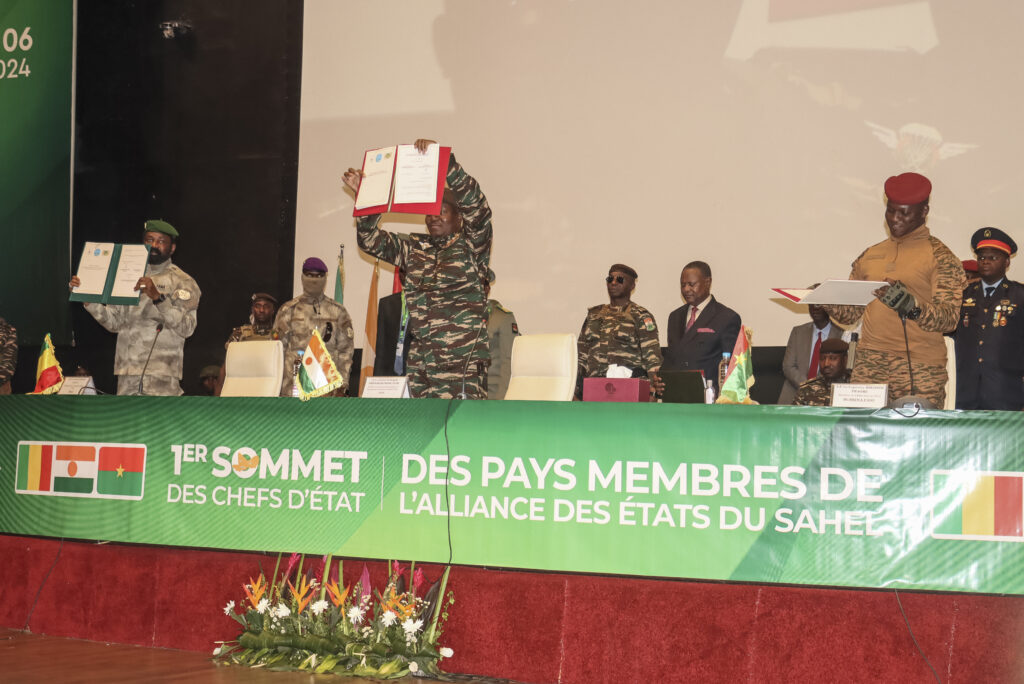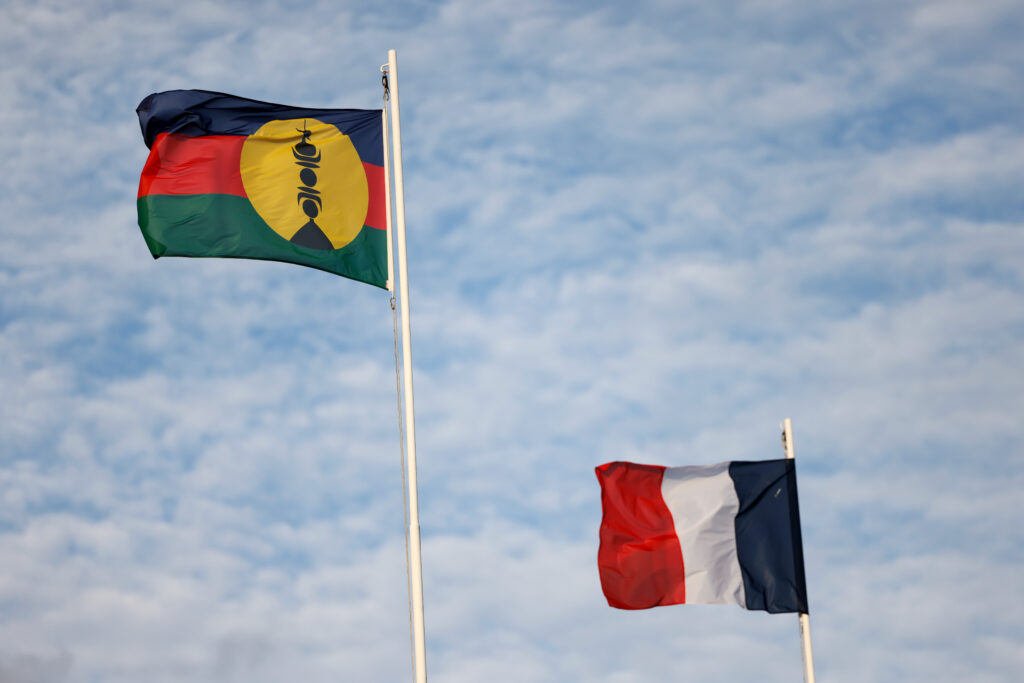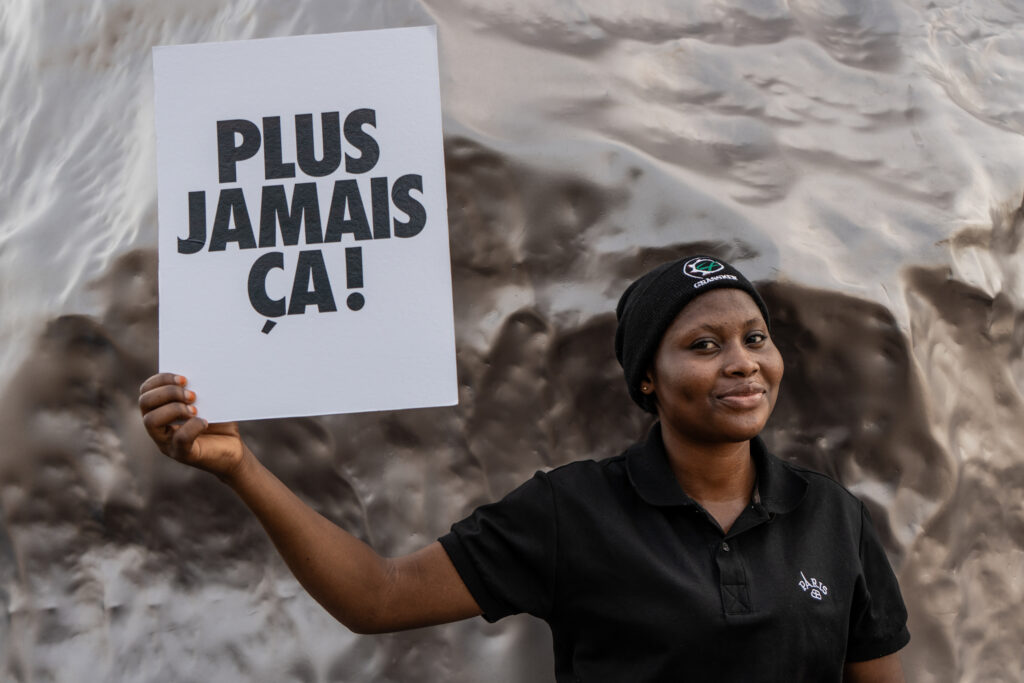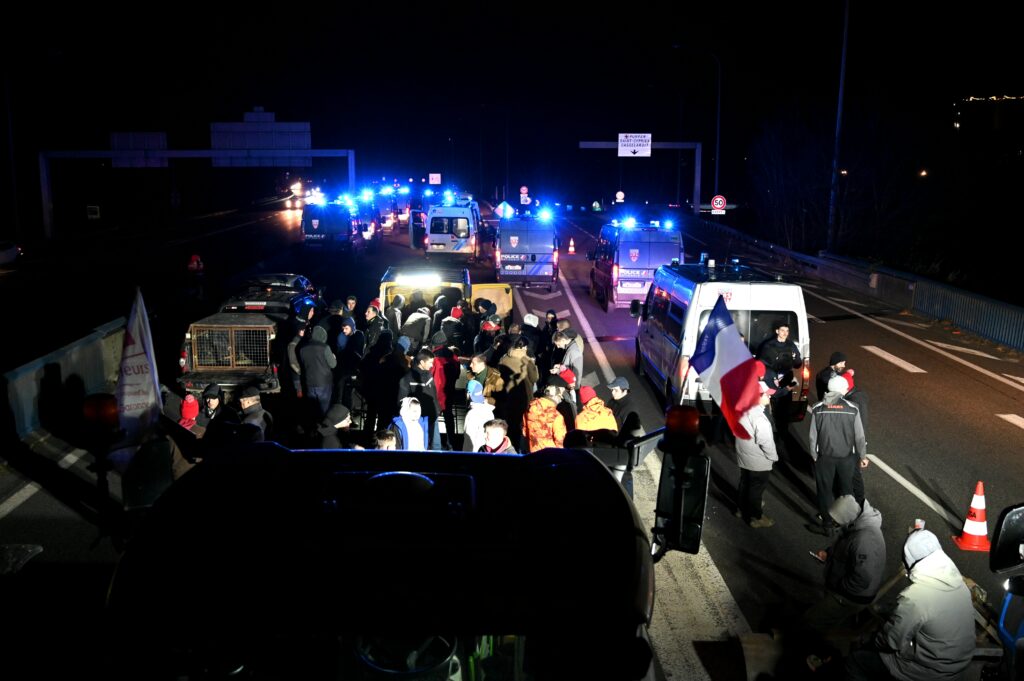Sahel juntas would have welcomed a coup in Benin: analystsTue, 16 Dec 2025 13:41:05 GMT
Military rulers in west Africa’s Sahel region may well have celebrated had a recent coup attempt in Benin resulted in another anti-Western junta in their neighbourhood, analysts said.Not least because Benin lies on the coast and access to ports is crucial for landlocked Burkina Faso, Mali and Niger — whose rulers formed the Alliance of …
Sahel juntas would have welcomed a coup in Benin: analystsTue, 16 Dec 2025 13:41:05 GMT Read More »
Macron réunira les élus calédoniens le 16 janvier pour “poursuivre le dialogue” sur l’avenir du territoire
Emmanuel Macron réunira les élus calédoniens le 16 janvier pour “poursuivre le dialogue” sur l’avenir institutionnel de l’archipel et “apporter des clarifications sur l’accord” de Bougival signé en juillet, a-t-il annoncé dans un courrier aux élus locaux, consulté par l’AFP.”A la suite des discussions initiées à l’occasion du Sommet pour l’avenir de la Nouvelle-Calédonie qui s’est tenu le 2 juillet dernier au palais de l’Elysée, afin d’apporter des clarifications à l’accord du 12 juillet, j’ai décidé d’organiser un nouveau temps d’échange pour poursuivre le dialogue”, écrit le président de la République.Il précise que ce “point d’étape, visant à ouvrir de nouvelles perspectives politiques auquel je souhaite vous associer” aura lieu le 16 janvier avec les “élus calédoniens”.Cette initiative intervient alors que le calendrier autour de l’accord de Bougival apparaît de plus en plus fragilisé. Le projet de loi sur l’organisation d’une consultation anticipée des Calédoniens sur cet accord ne sera finalement pas présenté mercredi en conseil des ministres, comme initialement envisagé, a confirmé lundi le porte-parolat du gouvernement.De nombreux doutes subsistent toutefois sur le format et les objectifs de la rencontre proposée par le président de la République.”Tout le monde l’a compris, on va essayer de nous faire rediscuter, de rouvrir l’accord de Bougival pour permettre au FLNKS de venir avec ses revendications”, a estimé le député calédonien Nicolas Metzdorf sur la chaîne NC La 1ère, regrettant que “la peur d’éventuelles nouvelles violences en Nouvelle-Calédonie (…) guide l’action politique” à Paris.Une source loyaliste a de son côté assuré à l’AFP que les Loyalistes (centre et droite anti-indépendance) ont été “au bout des concessions que l’on peut faire”. Selon cette source, les loyalistes refuseraient toute remise en cause des équilibres politiques de l’accord.Signé en juillet entre l’Etat, les indépendantistes et les non-indépendantistes, le projet d’accord de Bougival prévoit notamment la création d’un Etat de la Nouvelle-Calédonie inscrit dans la Constitution française. Il a toutefois été rejeté dès août par le Front de libération nationale kanak et socialiste (FLNKS), principale coalition indépendantiste.Si une majorité de forces politiques calédoniennes continue de soutenir le texte, plusieurs d’entre elles estiment qu’il doit être amendé afin de dégager un consensus jugé indispensable à sa mise en œuvre.Pour tenter de relancer le processus dans un archipel marqué par de graves violences au printemps 2024, qui ont fait 14 morts et rendu l’économie de l’archipel exsangue, la ministre des Outre-mer Naïma Moutchou avait proposé d’organiser en mars 2026 une “consultation citoyenne anticipée”, avant l’adoption de la loi constitutionnelle nécessaire à son application.Mais cette perspective a suscité des réserves, y compris parmi les soutiens de Bougival. L’Union nationale pour l’indépendance (UNI) a conditionné son appui à des modifications du texte et le Congrès calédonien, consulté pour avis le 8 décembre, a confirmé que le projet était dans l’impasse avec 19 votes pour, 14 contre et 19 abstentions.Début décembre, le Parti socialiste a en outre demandé au Premier ministre Sébastien Lecornu de “suspendre” la consultation anticipée, estimant qu’elle révélait “l’absence de consensus réel” autour de l’accord, ce qui rendait l’adoption du projet de loi improbable.
Benin jails around 30 people, mostly soldiers, over foiled coup attemptTue, 16 Dec 2025 13:24:36 GMT
Benin jailed on Tuesday around 30 people, most of them soldiers, accused of links to a thwarted coup attempt this month, legal sources told AFP, while several mutineers are still on the run.Soldiers appeared on national television on December 7 to announce President Patrice Talon had been deposed but the attempted putsch was swiftly defeated by …
CAN-2025: hôte et favori, le Maroc face à la meute
Dans l’obligation de remporter la Coupe d’Afrique des nations qu’il organise du 21 décembre au 18 janvier, avant d’accueillir le Mondial-2030, le Maroc d’Achraf Hakimi est l’archi-favori de “sa” compétition. Mais le Sénégal, l’Egypte ou le tenant du titre ivoirien, rêvent de contrecarrer les plans de tout un royaume.. Maroc: la victoire sinon rienPays hôte de la compétition, le Maroc d’Achraf Hakimi, sa superstar, en est aussi le grandissime favori, mais va devoir résister à une pression immense tout au long du tournoi.Premiers Africains au classement Fifa (11e), demi-finalistes de la Coupe du monde 2022, les Lions de l’Atlas, entraînés par Walid Regragui, viennent en novembre d’améliorer le record mondial de victoires consécutives toutes sélections confondues (17).Champion du monde des moins de 20 ans, performant chez les féminines, qualifié pour la finale de Coupe arabe avec les A’, invaincu chez les A lors des qualifications pour le Mondial 2026, le Maroc, à l’effectif le plus fort du tournoi, pourra compter en outre sur le soutien de tout le royaume. Il souhaite faire de cette CAN-2025 la plus grande de l’histoire et obtenir un second sacre, près de cinquante ans après l’unique titre continental du Maroc en 1976.C’est le revers de la médaille pour Achraf Hakimi, qui espère être remis de la blessure qui l’a tenu éloigné des terrains depuis novembre, et ses coéquipiers: pour cette CAN, Fouzi Lekjaa, le puissant président de la Fédération marocaine, n’ambitionne rien d’autre qu’une victoire.Le Maroc doit aussi montrer le faste de ses stades construits ou rénovés pour l’occasion et son savoir-faire en termes d’organisation. Le monde le regarde: en 2030, il sera le deuxième pays africain hôte d’un Mondial qu’il organisera avec l’Espagne et le Portugal.. Sénégal, les Lions de la Teranga avancent masquésVainqueur de la CAN 2021, le Sénégal – dans le groupe de la France lors du Mondial-2026 – est sur le papier l’adversaire le plus sérieux du Maroc pour la victoire finale. Les Lions de la Teranga, désormais entraînés par Pape Thiaw, allient parfaitement jeunesse et expérience, et s’appuient sur des cadres de classe mondiale comme Sadio Mané (117 sélections) et Kalidou Koulibaly (97 sélections). Le successeur d’Aliou Cissé – qui voit ses anciens protégés “aller au bout” – a décidé de faire confiance à la Ligue 1: dix de ses joueurs évoluent dans le championnat de France, sept autres sont déjà passés par la France.S’il est sorti prématurément de la CAN en 2023, éliminé en 1/8e par la Côte d’Ivoire, future championne, si historiquement les éditions organisées au Maghreb ne lui ont pas toujours réussi, le Sénégal, habitué des grandes échéances internationales est le challenger naturel du Maroc.. Egypte, le poids de l’histoireL’Égypte, nation la plus titrée de l’histoire de la CAN avec sept succès, court néanmoins derrière un huitième sacre depuis 15 ans déjà. Mais les Pharaons, qui peinent souvent en Coupe du monde, sont des spécialistes es-CAN.Leur sélectionneur Hossam Hassan dispose en outre d’une force de frappe offensive sans commune mesure, avec l’icône Mohamed Salah, le Mancunien Omar Marmoush et le Nantais Mostafa Mohamed.Pour sa cinquième CAN, avec l’espoir de disputer une troisième finale dans sa carrière, Salah, la star égyptienne, saura-t-elle mettre de côté les déboires avec son club de Liverpool ? De la réponse à cette question dépend le parcours de l’Égypte au Maroc. . Côte d’Ivoire, les tenants toujours présents Sacrée, chez elle, lors de la dernière édition de la CAN, la Côte d’Ivoire peut prétendre défendre son titre et devenir ainsi la première équipe à réaliser le doublé depuis l’Égypte en 2010.Émerse Faé, son sélectionneur, se serait pourtant bien passé des propos de Nicolas Pépé, hostiles aux joueurs bi-nationaux, qui l’ont obligé à se séparer de son attaquant, cadre de l’équipe depuis plusieurs saisons. Simon Adingra, héros de la dernière finale, est hors de forme donc hors du groupe.. Algérie, Nigeria, Cameroun à ne jamais sous-estimerEliminés prématurément lors de deux précédentes éditions, les Fennecs ont retrouvé une certaine solidité avec leur nouveau sélectionneur Vladimir Petkovic et possèdent toujours l’un des effectifs les plus costauds sur le papier. Un effectif où pourrait briller le gardien de but Luca Zidane, l’un des fils de la légende tricolore. Le Nigeria n’est pas parvenu à se qualifier pour le Mondial-2026 et le Cameroun n’arrive pas à régler le conflit entre Samuel Eto’o et son ministère de tutelle mais les deux nations sont des bêtes de CAN (trois titres pour les Super Eagles, cinq pour les Lions indomptables).
Dermatose: Lecornu demande d’accélérer la vaccination, va recevoir les syndicats agricoles
Sébastien Lecornu, focalisé depuis plusieurs semaines sur le budget, a pris le dossier agricole en main mardi et demandé une “accélération” de la vaccination contre la dermatose nodulaire contagieuse (DNC) qui touche les élevages et a provoqué une mobilisation d’agriculteurs notamment dans le Sud-Ouest qui ne faiblit pas.Il recevra “dans la semaine” les différents syndicats agricoles, dont certains critiquent la gestion de cette maladie animale et qui sont aussi indignés par la perspective d’une signature du traité de libre-échange entre l’Union européenne et des pays latino-américains du Mercosur.Le Premier ministre a tenu une réunion mardi matin avec plusieurs ministres et des préfets pour évoquer les moyens de lutter contre l’épizootie.Il tiendra une deuxième réunion à ce sujet à 17H30. Dans l’intervalle, il a demandé à ses ministres “une accélération de la stratégie vaccinale qui doit davantage tenir compte de la réalité de chaque département” pour “protéger nos éleveurs et l’élevage français”, appelant à “garantir” une “disponibilité des doses” de vaccins “plus forte”.Au lendemain d’une visite de la ministre de l’Agriculture, Annie Genevard, en Occitanie, la mobilisation contre la gestion de l’épizootie ne retombait pas mardi, au septième jour consécutif, avec plusieurs axes routiers et ferroviaires bloqués dans le Sud-Ouest.Une partie des agriculteurs manifeste sa colère depuis plusieurs jours contre la stratégie gouvernementale d’abattage systématique d’un troupeau de bovins dès la détection d’un cas de cette maladie très contagieuse.Au total, 113 foyers de dermatose nodulaire contagieuse ont été recensés en France- Mercosur -L’exécutif doit par ailleurs gérer une autre colère agricole contre la signature du traité de libre-échange avec des pays du Mercosur. La FNSEA, premier syndicat agricole, a appelé à manifester à Bruxelles jeudi à l’occasion du sommet des chefs d’Etat européens invités à valider l’accord.La patronne du Rassemblement national, Marine Le Pen, a appelé le président Emmanuel Macron à “dire non” à ce traité “parce qu’il en va de la survie de notre agriculture et donc de la souveraineté de notre pays”, plutôt que de demander un report en 2026 du vote prévu à Bruxelles cette semaine. M. Macron a redit aux dirigeants de l’UE son opposition à la signature de l’accord. Paris demande que les décisions sur ce traité soient repoussées. Depuis le début de l’épidémie de DNC, en Savoie cet été, l’État tente de contenir la propagation du virus en se basant sur “trois piliers”: l’abattage systématique dès la détection d’un cas, la vaccination et la restriction de mouvements.Cette stratégie a été réaffirmée lundi par Mme Genevard, alors que la Coordination rurale, deuxième syndicat de la profession, proche de l’extrême droite, la Confédération paysanne, classée à gauche, et plus localement la FNSEA, premier syndicat, demandent la fin de l’abattage total et un élargissement de la zone vaccinale.Mme Genevard a assuré “entendre” la détresse des éleveurs lundi à Toulouse. L’élargissement du territoire de vaccination dans le Sud-Ouest, visant 600.000 à un million de bovins, est “un premier infléchissement du protocole”, a-t-elle estimé.- “Déconnectée” -“Au vu des annonces de la ministre (Annie Genevard)”, les blocages “ne sont pas près de se lever”, a prévenu mardi Guillaume Bénazet, patron des Jeunes Agriculteurs de Haute-Garonne. “Tout ce qu’on avait proposé, notamment la fin de l’abattage total, rien n’a été étudié. Donc on continue”. Blocages et manifestations se poursuivaient mardi dans le Sud-Ouest. Entre la Haute-Garonne et les Pyrénées-Atlantiques, l’autoroute A64 était toujours coupée sur 180 km. Tracteurs et bottes de paille obstruent encore cette autoroute à Carbonne, près de Toulouse, où les agriculteurs ont passé une quatrième nuit.L’axe ferroviaire Bordeaux-Marseille est aussi bloqué entre Toulouse et Narbonne sur un passage à niveau à Villefranche-de-Lauragais (Haute-Garonne), selon SNCF Réseau. Environ 200 agriculteurs empêchent toute circulation avec palettes et bottes de foin, tandis que de gros feux ont été allumés au niveau des routes à proximité.Le blocage devrait perdurer “au moins pour la journée”, a précisé Baptiste Marquié, 38 ans, exploitant céréalier à Monesrol, présent en solidarité des éleveurs. “On détruit plus que des élevages, on détruit des familles et des générations de travail”, a-t-il déploré.Mme Genevard “méprise les agriculteurs, elle est déconnectée, elle n’y comprend rien”, a estimé Lionel Candelon, président de la Chambre d’agriculture du Gers et leader régional de la Coordination rurale.”DNC/Mercosur, même combat !”, ont affirmé mardi matin des agriculteurs au niveau de Méré, dans les Yvelines, où ils ont bloqué la route nationale 12 en direction de Paris.”Il faut traiter (la DNC) en priorité, en même temps que le Mercosur, pour moi tout est lié”, a assuré Vincent Thoumieux, secrétaire général des Jeunes agriculteurs des Yvelines, à l’origine de la mobilisation.





